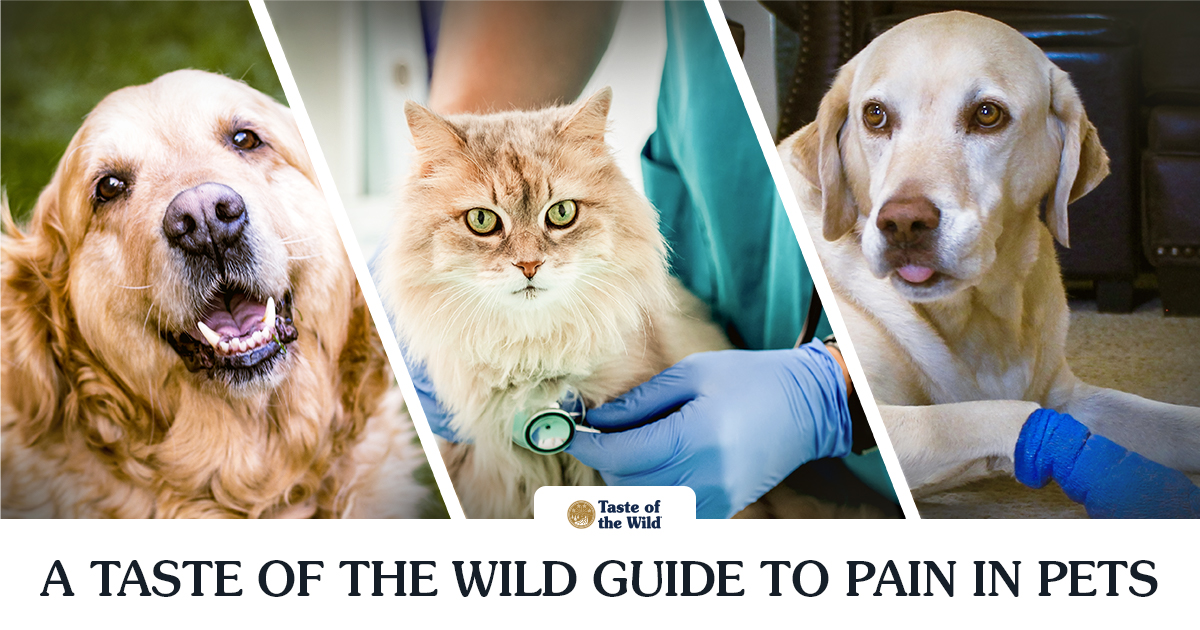Pain in Pets: A Guide by Taste of the Wild
Thursday, January 13, 2022 | Health

A pet in pain can be more emotionally painful for pet owners than we ever truly realize. Cats and dogs can’t tell us where it hurts, and that’s even if they want to tell us at all. Due to natural instincts, many pets actually work to hide the fact that they might be in pain. How can you help your pet if you don’t even know if they’re in need?
There’s also the nature of the pain to worry about. A sprained paw is a lot different than creaky, arthritic joints. Your pet generally isn’t going to be able to tell you how it happened or, perhaps more importantly, how long it’s been happening. While some aspects of pet pain might remain a mystery, this Taste of the Wild Guide to Pain in Pets can help a pet parent understand what you need to know and then take the steps needed to help your pet in pain.
Signs of Pain in Pets

Our pets have an uncanny way of sensing when something’s wrong with us. But can we say the same for ourselves as pet parents? Do we intuitively know when something’s amiss with our dogs or cats? If they were in pain, would we know it? Our pets don’t make it easy, that’s for sure. But if you’re slightly educated about pet pain —for instance, if you know that sudden lethargy or loss of appetite might be signs of pain— you can start helping your pet immediately.
Acute vs. Chronic Pain in Pets

Most pain is classified as either acute or chronic. Acute pain tends to come on suddenly or lasts for a short time, dissipating once inflammation resolves and healing occurs. An ankle twist, a tail slammed in a door: These types of pain tend to start feeling better with elevation and reduced swelling. But chronic pain is more complicated and generally lasts longer, sometimes even for the pet’s lifetime. Arthritis is an example of chronic pain: it can’t be cured and tends to progress over time.
But how do you tell the difference between acute and chronic when your pet is in pain? And what are the signs of pain?
READ MORE ABOUT ACUTE AND CHRONIC PAIN IN PETS
The Do’s and Don’ts of Pet Pain Relief

Once you see signs of pain in your pet and then determine the nature of said pain, you can start treating it (or having it treated by your veterinarian). But, as with all things, there is a right way and a wrong way to help ease a pet’s pain. And the wrong way can exacerbate the problem, sometimes with disastrous results. For example, there’s a relatively common belief that some over-the-counter pain medications meant for people can be applied to pets. Aspirin is relatively harmless for people, so the same goes for pets, right?
Unfortunately, that kind of well-meaning thinking has led to potentially serious health problems for both cats and dogs. Here are some things to do and somethings to definitely not do when dealing with pet pain relief and pain management.
READ MORE ABOUT WHAT TO DO IF YOU SUSPECT YOUR PET IS IN PAIN
It’s hard having a pet in pain. There are no blanket answers, and your pet often won’t be helpful in diagnosing or treating the problem. But with a little guidance, you can make a painful situation better for your pet. And maybe even make your pet pain free.
The information in this blog has been developed with our veterinarian and is designed to help educate pet parents. If you have questions or concerns about your pet’s health or nutrition, please talk with your veterinarian.




